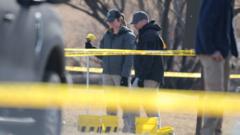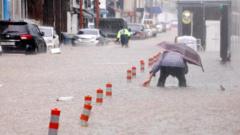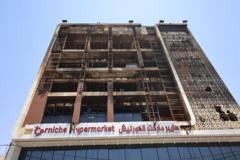The collision between an American Airlines jet and a US Army helicopter raises questions about air traffic control and safety protocols.
**Tragedy Strikes: Washington DC Plane Crash Claims 67 Lives**

**Tragedy Strikes: Washington DC Plane Crash Claims 67 Lives**
A devastating plane crash near Washington DC leaves families mourning as investigations unfold.
In a shocking incident on Wednesday evening, a passenger plane operating as American Airlines flight 5342 collided with a military helicopter near Ronald Reagan Washington National Airport, resulting in the presumed deaths of 67 individuals. Initial reports indicate that the helicopter, a Sikorsky H-60 Black Hawk, was flying above the allowed altitude at the time of the crash.
Eyewitness accounts describe the moment when the Bombardier CRJ700 jet, originating from Wichita, Kansas, approached the airport, seemingly in a normal flight path until it abruptly banked hard to the right, trailing sparks before crashing into the icy Potomac River. The helicopter, which was on a proficiency flight, also spiraled down and eventually settled upside down on the water’s surface.
Detailed analyses of air traffic control communications have revealed that the controller attempted to alert the helicopter about the incoming passenger flight mere seconds prior to the tragic collision. Despite the helicopter crew confirming awareness of the plane, the accident occurred around 21:00 local time without any further evasive action.
First responders launched a significant recovery effort amid frigid conditions. Initially searching for survivors, the focus quickly shifted to the grim task of recovering bodies as the realization dawned that there would likely be none. To date, 41 victims have been recovered, including three military personnel aboard the helicopter. The victims include international figure skaters, flight attendants, and a young pilot whose fate has touched many hearts.
The investigation into the crash, led by the National Transportation Safety Board (NTSB), aims to discern the factors contributing to the accident, including the altitude at which the helicopter was flying and whether air traffic control was operating properly. A preliminary report is expected within the next month, while additional scrutiny addresses reported understaffing at the control tower during the time of the crash.
Former President Trump commented on the tragedy, attributing part of the blame to operational standards and air traffic controller policies amid ongoing discussions about aviation safety. Trump suggested that the helicopter’s altitude was a critical deviation, something that needs thorough examination as the investigation unfolds.
As the air travel community continues to grapple with this grim incident, experts emphasize the rarity of crashes in busy airspaces like that of Washington DC, which are highly regulated and monitored. With numerous factors at play, this tragic occurrence underscores the pressing need for stringent safety measures and protocols within the aviation industry.
Eyewitness accounts describe the moment when the Bombardier CRJ700 jet, originating from Wichita, Kansas, approached the airport, seemingly in a normal flight path until it abruptly banked hard to the right, trailing sparks before crashing into the icy Potomac River. The helicopter, which was on a proficiency flight, also spiraled down and eventually settled upside down on the water’s surface.
Detailed analyses of air traffic control communications have revealed that the controller attempted to alert the helicopter about the incoming passenger flight mere seconds prior to the tragic collision. Despite the helicopter crew confirming awareness of the plane, the accident occurred around 21:00 local time without any further evasive action.
First responders launched a significant recovery effort amid frigid conditions. Initially searching for survivors, the focus quickly shifted to the grim task of recovering bodies as the realization dawned that there would likely be none. To date, 41 victims have been recovered, including three military personnel aboard the helicopter. The victims include international figure skaters, flight attendants, and a young pilot whose fate has touched many hearts.
The investigation into the crash, led by the National Transportation Safety Board (NTSB), aims to discern the factors contributing to the accident, including the altitude at which the helicopter was flying and whether air traffic control was operating properly. A preliminary report is expected within the next month, while additional scrutiny addresses reported understaffing at the control tower during the time of the crash.
Former President Trump commented on the tragedy, attributing part of the blame to operational standards and air traffic controller policies amid ongoing discussions about aviation safety. Trump suggested that the helicopter’s altitude was a critical deviation, something that needs thorough examination as the investigation unfolds.
As the air travel community continues to grapple with this grim incident, experts emphasize the rarity of crashes in busy airspaces like that of Washington DC, which are highly regulated and monitored. With numerous factors at play, this tragic occurrence underscores the pressing need for stringent safety measures and protocols within the aviation industry.





















